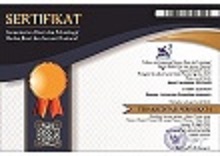EVALUASI RUANG KELAS GAMBAR MANUAL UNTUK MENINGKATKAN KENYAMANAN PADA MASA PANDEMI DI SMK NEGERI 6 BANDUNG
Abstract
A disease similar to pneumonia emerged in late December 2019 in Wuhan, China. An illness caused by a virus that spreads rapidly until 66% of workers at the fish market get infected. WHO declared that the plague caused by the SARS-CoV-2 virus was a global pandemic on March 11, 2020. The government decided to restrict the activities held in public places, including closing schools and holding distance learning during the pandemic. Reopening schools has to be aware of a few things because this virus can spread directly or indirectly (the objects that are contaminated or airborne). To minimize the virus spread, the thermal condition and lightning in the classroom have to be according to the standards. This research uses evaluative research with a qualitative approach. The evaluative research is used to investigate the compatibility of the drawing studio with the regulation of facilities and infrastructures is Permendikbud No. 34 Tahun 2018 and guidelines to school reopening during Covid-19 pandemic according to PAUDDIKDASMEN also for thermal, lightning comfort are according to ASHRAE and SNI. The outcomes of this research are both the infrastructures also the facilities haven't reached the standard yet. However, some of the facilities are already compatible with the regulation. The reopening plan for the drawing studio needs some changes, including limiting the students in the classroom, reorganizing the drawing desk within 1,5 m distance, confirming there are cleaning schedules for the studio by disinfecting the whole classroom, and also wiping the surface touched by the pupils. Thermal and lighting conditions are still haven't reached the standard yet. However, the humidity in the drawing studio is already compatible with the regulation.
Keywords: Drawing studio evaluation; Covid-19 Pandemic; Thermal and Visual Comfort.
Full Text:
PDFReferences
ASHRAE. (2020). Standard 55-2020 Thermal Environmental Conditions for Human Occupancy (ANSI Approved). https://ashrae.iwrapper.com/ASHRAE_PREVIEW_ONLY_STANDARDS/STD_55_2020
Bashir, I., Hamid, B., Jhanjhi, N. Z., & Humayun, M. (2020). SYSTEMATIC LITERATURE REVIEW AND EMPIRICAL STUDY FOR SUCCESS FACTORS : CLIENT AND VENDOR PERSPECTIVE. Journal of Engineering Science and Technologi, 15(4), 2781–2808.
Buonanno, M., Welch, D., Shuryak, I., & Brenner, D. J. (2020). Far-UVC light (222 nm) efficiently and safely inactivates airborne human coronaviruses. Scientific Reports, 10(1), 1–8. https://doi.org/10.1038/s41598-020-67211-2
Burroughs, H. E., & Hansen, S. J. (2011). Managing indoor air quality (5th ed.). The Fairmont Press, Inc. http://dl.mozh.org/up/Managing_Indoor_Air_Qualityy.pdf
Choi, J. H., Loftness, V., & Aziz, A. (2012). Post-occupancy evaluation of 20 office buildings as basis for future IEQ standards and guidelines. Energy and Buildings, 46, 167–175. https://doi.org/10.1016/j.enbuild.2011.08.009
Groat, L., & Wang, D. (2013). Architectural Research Methods (Second Edi). John Wilet & Sons, Inc.
Kamaruzzaman, S. N., Emma Zawawi, M. A., Pitt, M., & Don, Z. M. (2010). Occupant feedback on indoor environmental quality in refurbished historic buildings. International Journal of Physical Sciences, 5(3), 192–199.
Kampf, G., Todt, D., Pfaender, S., & Steinmann, E. (2020). Persistence of coronaviruses on inanimate surfaces and their inactivation with biocidal agents. Journal of Hospital Infection, 104(3), 246–251. https://doi.org/10.1016/j.jhin.2020.01.022
Lotfi, M., Hamblin, M. R. ., & Rezaei, N. (2020). COVID-19: Transmission, prevention, and potential therapeutic opportunities. Elsevier Public Health Emergency Collection, PMC7256510. https://doi.org/https://dx.doi.org/10.1016%2Fj.cca.2020.05.044
Mecenas, P., da Rosa Moreira Bastos, R. T., Rosário Vallinoto, A. C., & Normando, D. (2020). Effects of temperature and humidity on the spread of COVID-19: A systematic review. PLoS ONE, 15(9 September), 1–21. https://doi.org/10.1371/journal.pone.0238339
Morawska, L., Tang, J. W., Bahnfleth, W., Bluyssen, P. M., Boerstra, A., Buonanno, G., Cao, J., Dancer, S., Floto, A., Franchimon, F., Haworth, C., Hogeling, J., Isaxon, C., Jimenez, J. L., Kurnitski, J., Li, Y., Loomans, M., Marks, G., Marr, L. C., … Yao, M. (2020). How can airborne transmission of COVID-19 indoors be minimised? Environment International, 142(May). https://doi.org/10.1016/j.envint.2020.105832
Permana, A. Y., Akbardin, J., Permana, A. F. S., & Nurrahman, H. (2020). The concept of optimal workplace in providing a great experience to improve work professionalism in the interior design of PLN Corporate university, Ragunan, Jakarta. International Journal of Advanced Science and Technology, 29(7), 3238–3254. http://sersc.org/journals/index.php/IJAST/article/view/18953
Permana, A. Y., Aprilia, D. I., & Teniola, N. Q. I. (2019). Teacher Skills Through the Development of Design a nd Develop Learning Program Taedes 401 ( gov . au ) for Building Core Skill a nd Employability Skills for Vocational High School. Advances in Social Science, Education and Humanities Research, 379(Veic), 385–395. https://www.atlantis-press.com/proceedings/veic-19/125927437
Permana, A. Y., Mardiana, R., Dewi, N. I. K., Sumanta, R. V. V., Ezzaty, F. M., & Nareswari, P. A. (2022). Evaluation of Classroom Performance in The Post-Covid- 19 New Normal Era at The Building Program Vocational High School. Journal of Southwest Jiaotong University, 15(2), 126–145.
Permana, A. Y., & Wijaya, K. (2017). Spatial change transformation of educational areas in Bandung. IOP Conference Series: Earth and Environmental Science, 99, 012029. https://doi.org/10.1088/1755-1315/99/1/012029
Preiser, W. F., & Vischer, J. C. (2005). Assessing Building Performance. In Assessing Building Performance. Linacre House, Jordan Hill, Oxford OX2. https://doi.org/10.4324/9780080455228
Riddell, S., Goldie, S., Hill, A., Eagles, D., & Drew, T. W. (2020). The effect of temperature on persistence of SARS-CoV-2 on common surfaces. Virology Journal, 17(1), 1–7. https://doi.org/10.1186/s12985-020-01418-7
Standar Nasional Indonesia, B. S. N. (2001). Tata Cara Perancangan Sistem Pencahayaan Buatan pada Bangunan Gedung. SNI 03-6575-2001 Tentang Tata Cara Perancangan Sistem Pencahayaan Buatan Pada Bangunan Gedung, 1–32.
Surya Dharma, MPA., P. . (2008). Pendekatan, jenis, dan metode penelitian pendidikan.
Wijaya, K., Permana, A. Y., Sugandi, D., & Nurrohman, F. (2020). Settlement Pattern of the Village of Dayeuh Luhur, Sumedang. Journal of Architectural Research and Education, 2(1), 55. https://doi.org/10.17509/jare.v2i1.24292
Wu, Y. C., Chen, C. S., & Chan, Y. J. (2020). The outbreak of COVID-19: An overview. Journal of the Chinese Medical Association, 83(3), 217–220. https://doi.org/10.1097/JCMA.0000000000000270
DOI: https://doi.org/10.17509/jaz.v6i1.43807
Refbacks
- There are currently no refbacks.
Copyright (c) 2023 Vena Ventiany Sumanta, Asep Yudi Permana, Riskha Mardiana

This work is licensed under a Creative Commons Attribution-ShareAlike 4.0 International License.





